Montana’s lakes and rivers showcase a picturesque and calming landscape, yet their peaceful appearance can be deceiving. Hidden beneath the undulating waters is a realm of peril, inhabited by some of the region’s most formidable creatures. Ranging from intimidating predators capable of sudden attacks to venomous beings with fatal bites, Montana’s waters can be hazardous for those who venture too near.
In this article, we will explore some of the most dangerous animals of Montana’s lakes and rivers while offering essential advice for maintaining safety amidst these stunning natural marvels.
Are Montana’s Lakes And Rivers Dangerous?
While Montana’s lakes and rivers may not be as dangerous as those in some southern states, it would be unwise to label them as completely safe. Alongside frigid temperatures during winter, certain animals may conceal themselves beneath the water and pose significant threats to humans. Some predatory creatures might be drawn to the water source and have the potential to attack unexpectedly.
Moreover, venomous reptiles could be concealed in the vegetation near the shoreline. While these natural wonders can be appreciated safely with adequate preparation and care, it is crucial to remain aware of potential dangers.
A List Of The Most Dangerous Animals In Montana’s Lakes And Rivers
From massive predators to venomous creatures, this list reveals the most dangerous animals found in Montana’s aquatic habitats.
Snapping Turtle (Chelydra serpentina)
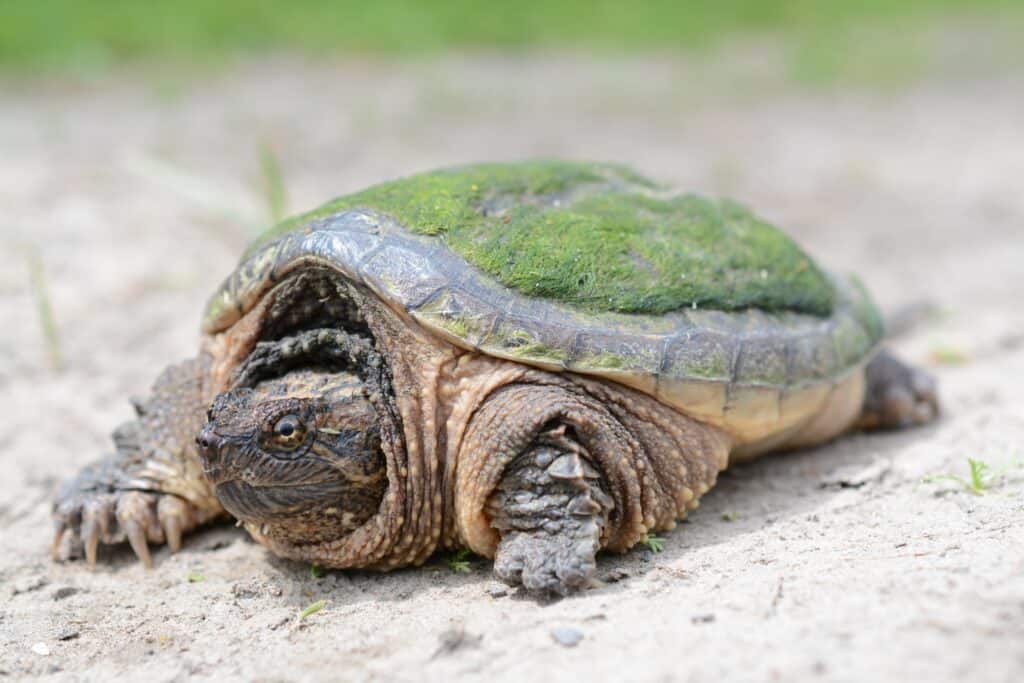
Their bites can be quite painful and potentially severe, leading to infections, excessive bleeding, or even finger amputation.
©Trevor Meunier/Shutterstock.com
The snapping turtle is a sizable species in Montana, recognized for its intimidating appearance. These turtles possess a shell length varying from 8 to 18.5 inches, and their tails nearly equal their shells in length. The tail showcases jagged keels, and the shell’s hue ranges from dark brown to tan, with occasional black. Snapping turtles display unique tubercles on their necks and legs, making them easy to identify.
These reptiles are commonly found in Montana’s southeastern region, within the Yellowstone River system and its tributaries, particularly along the Tongue River drainage. They exhibit the most activity from May to August and are intriguingly regarded as native on the state’s east side but invasive on the west.
Snapping turtles lives in creeks, marshes, swamps, pools, lakes, streams, bogs, and rivers.
In Duisburg, Germany, on February 6th, 2009, an escaped snapping turtle went on a rampage, biting and attacking people. The situation became so dangerous that the police were called to capture the animal.
Although their appearance may be fearsome, snapping turtles do not generally exhibit aggression and will only attack if they sense danger or vulnerability. Nevertheless, their bites can be quite painful and potentially severe, leading to infections, excessive bleeding, or even finger amputation.
While their beaks can inflict injuries, there are no known reports of fatalities caused by these reptiles. Yet, you should not take these turtles lightly, as they have the capacity to sever fingers or cause serious wounds. Surprisingly, the average bite force of a snapping turtle is approximately 209 Newtons! In comparison, the average human generates around 70 to 150 newtons while chewing foods like carrots or meat.
Western Terrestrial Garter Snake (Thamnophis elegans)
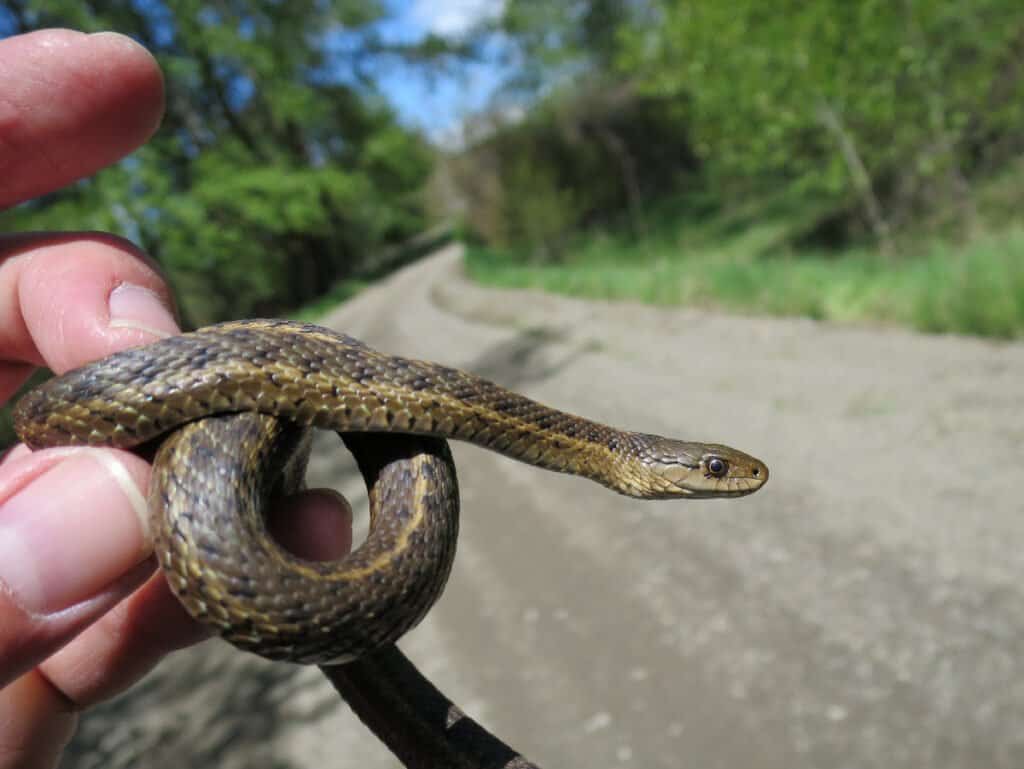
Generally, they do not exhibit aggression towards humans, but they may bite if they sense danger.
©Randy Bjorklund/Shutterstock.com
The western terrestrial garter snake is native to Montana and can be discovered throughout the state. You are more likely to encounter western terrestrial garter in rivers and lakes than any other type of snake. Often found in proximity to water, these snakes exhibit an overall olive hue with pale yellow undersides. They also feature a yellow stripe extending the full length of their bodies. Typically, these medium-sized snakes measure between 18 and 41 inches.
Western terrestrial garter snakes display adaptability and inhabit various environments, including deserts, plains, mountains, meadows, forests, and areas near lakes and gentle streams. They exhibit cryptic coloration to blend into their surroundings and evade predators.
Generally, they do not exhibit aggression towards humans, but they may bite if they sense danger. When guarding their eggs, female western terrestrial garter snakes may display aggression towards humans who come too close, perceiving them as a potential threat.
A bite from these snakes usually results in mild irritation and swelling around the affected area. Individuals showing signs, such as hives, nausea, vomiting, and dizziness, must promptly seek medical care.
Painted Turtle (Chrysemys picta)
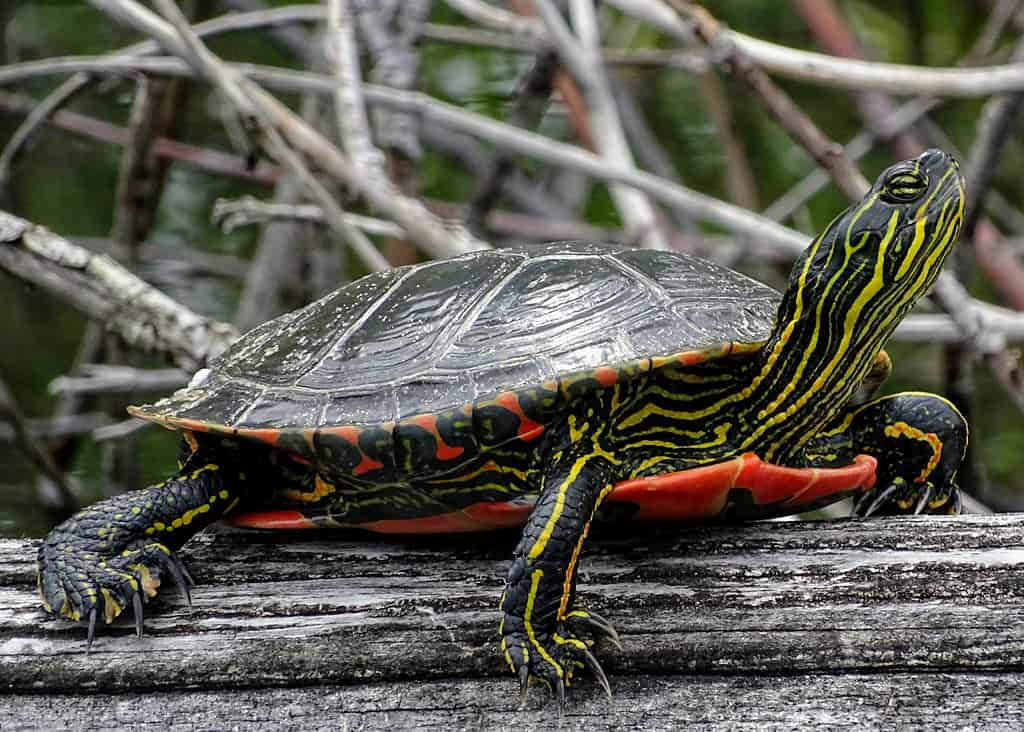
Though painted turtles have been known to bite on occasion, particularly when startled or annoyed, these incidents are rare and undocumented.
©iStock.com/Dave Acheson Photography
Throughout Montana, the painted turtle thrives in lower elevations, with only a handful of central counties lacking documented sightings. This medium-sized turtle is easily recognizable by its dark shell adorned with olive lines on the carapace (top shell), which separate the large scutes (scales). Both the carapace and plastron (bottom shell) edges feature red and black markings, while the head, neck, and limbs exhibit yellow stripes. Adult painted turtles vary in size from 2.5 to 10 inches.
The painted turtle is often the most populous turtle species within its habitat, with densities ranging from 10 to 840 individuals per hectare (2.5 acres) of water surface. These turtles are predominantly aquatic creatures, venturing away from water only for egg-laying. However, they are known to bask on logs and rocks in the sun, especially in cooler weather.
Though painted turtles have been known to bite on occasion, particularly when startled or annoyed, these incidents are rare and undocumented. Bites from these turtles can be quite painful and can be provoked by any discomfort. The more significant health risk comes from the potential transmission of salmonella bacteria, which can be carried by seemingly healthy and clean turtles.
People may contract salmonella through contact with turtles, their water, their supplies, or their environment. Even minimal contact with these reptiles can result in health issues such as diarrhea and abdominal pain. In severe cases, these diseases can be fatal for young children.
Inland Floodwater Mosquito (Aedes vexans)

These mosquitoes are the most significant pest due to their breeding potential in floodwater habitats, widespread distribution, and abundance.
©Roziline/Shutterstock.com
The dominant mosquito species in most of North America, including Montana, is none other than the inland floodwater mosquito. The base of every leg segment on this mosquito has a slim white band set against a background of black scales, while most of its abdominal segments are adorned with white-scaled bands indented at the center to form a sideways “B” shape. Inland floodwater mosquitoes range in size from 0.15 to 0.4 inches long.
Inland floodwater mosquitoes live in a variety of freshwater habitats, including irrigated fields or temporary pools like detention basins, as well as permanent bodies of water.
These mosquitoes are the most significant pest due to their breeding potential in floodwater habitats, widespread distribution, and abundance. They are notorious for transmitting dangerous pathogens to humans and pets, such as dengue, western equine encephalitis, yellow fever, West Nile virus (CDC), St. Louis encephalitis, and dog heartworm.
Moreover, they are vicious, especially during the day, and light attracts them. Inland floodwater mosquitoes are blood-sucking insects that seek human and animal blood to survive.
Every year, mosquito-borne diseases claim the lives of approximately 725,000 people, according to estimates by the World Health Organization (WHO).
Dangerous Animals Around Montana’s Lakes And Rivers
In addition to the animals residing within Montana’s lakes and rivers, there are also predators and dangerous animals in the surrounding areas that pose a threat to humans and pets. Let’s take a brief look at these animals.
Grizzly Bear (Ursus arctos horribilis)
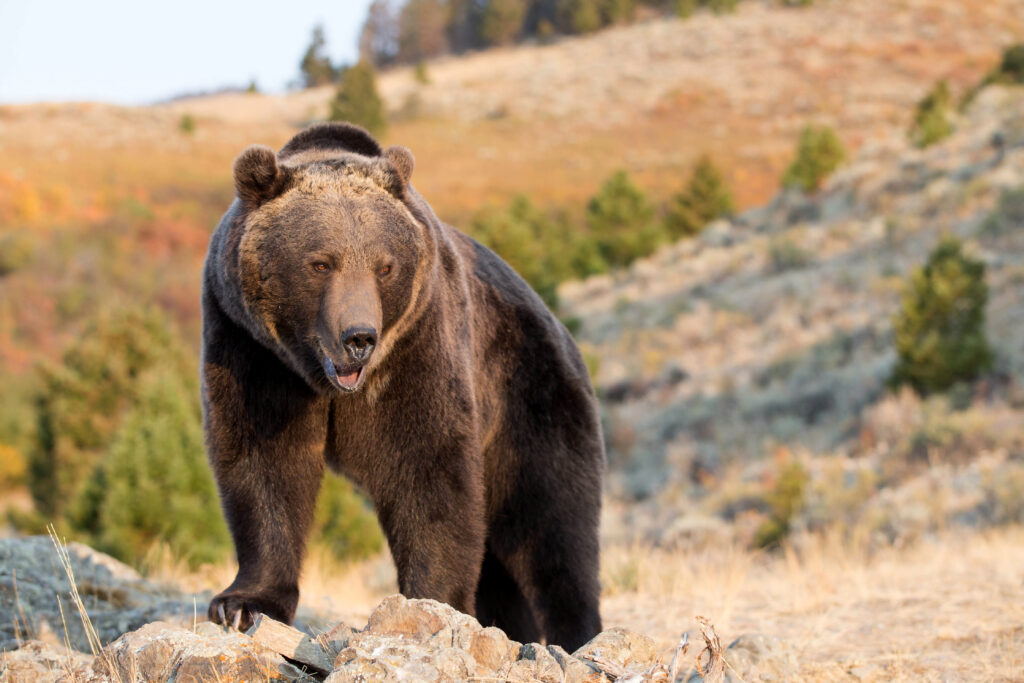
Montana has the largest number of grizzly bears after Alaska.
©Dennis W Donohue/Shutterstock.com
Grizzly bears are the official animal of Montana. They primarily inhabit the western parts of the state. However, they are increasingly wandering into areas where they have not been seen for decades.
These massive animals can range in color from almost white to dark brown, and they have a large shoulder hump, a distinct dished face, and short ears. Grizzly bears can weigh over 700 pounds and grow up to 8 feet in length. They tend to live near water bodies like rivers and wetlands because they love to eat fish.
Montana has the largest number of grizzly bears after Alaska.
Despite their impressive size and strength, grizzly bear attacks on humans are rare, with roughly 44 attacks happening each year, and 8 of them being fatal between 2020-2022 in North America.
These mammals are one of the most dangerous animals in Montana. Grizzly bears have super physical strength and can deliver a powerful bite force of up to 1,000 psi. They are capable of splitting a human body in half within seconds. Surprisingly, grizzly bears are capable of sprinting up to 100 yards in just eight seconds, which makes them faster than an average dog. However, grizzly bears are unlikely to attack unless provoked or caught off guard.
Prairie Rattlesnake (Crotalus viridis)
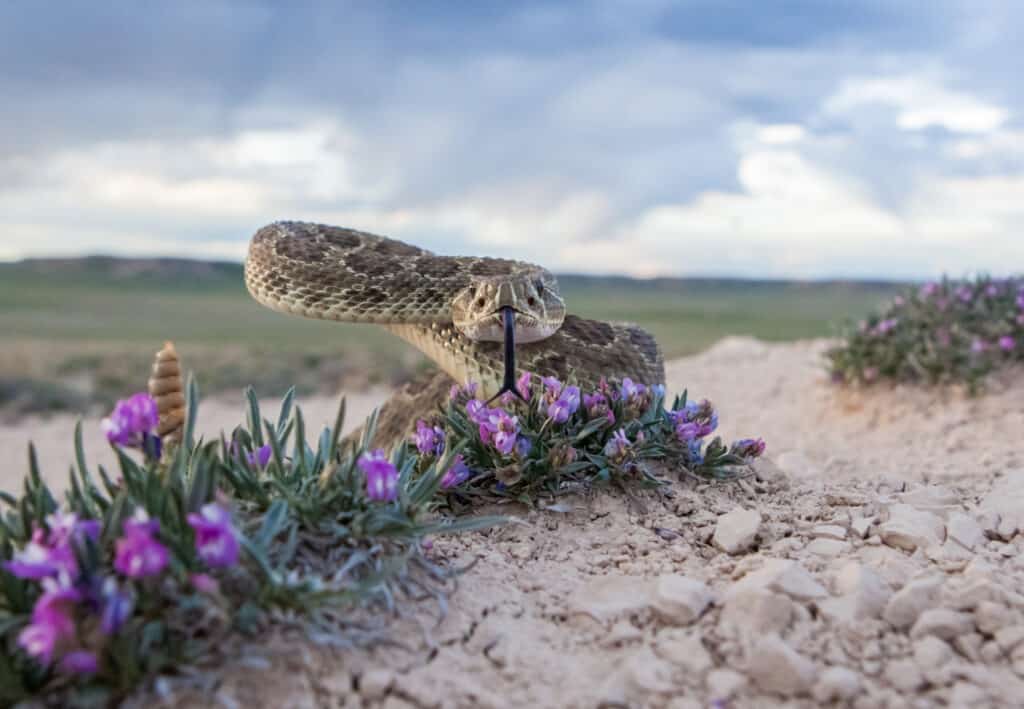
Their venom can cause severe discomfort, inflammation, and profuse bleeding at the site of the bite.
©iStock.com/Matt Kaminski
The prairie rattlesnake is the sole venomous snake out of the ten distinct species in Montana. This reptile is recognized for its maximum length of approximately five feet, featuring a unique triangular head and body adorned with dark patterns that evolve into ring-like shapes close to the tail. They are highly adept at sensing temperature changes, especially heat.
Sources of water, such as streams, lakes, and rivers, along with open prairies, forests, wooded areas, shrubs, caverns, and rocky outcrops, are some of the places where these reptiles tend to live.
Although they possess venom, prairie rattlesnakes do not exhibit aggressive behavior. They will only confront humans if they feel threatened. Their venom can cause severe discomfort, inflammation, and profuse bleeding at the site of the bite.
In rare cases, the venom may result in nausea, swelling in the mouth and throat regions, breathing difficulties, dizziness, increased salivation, and even sudden collapse and shock. It is crucial to promptly seek medical assistance after experiencing a rattlesnake bite.
Black Bear (Ursus americanus)
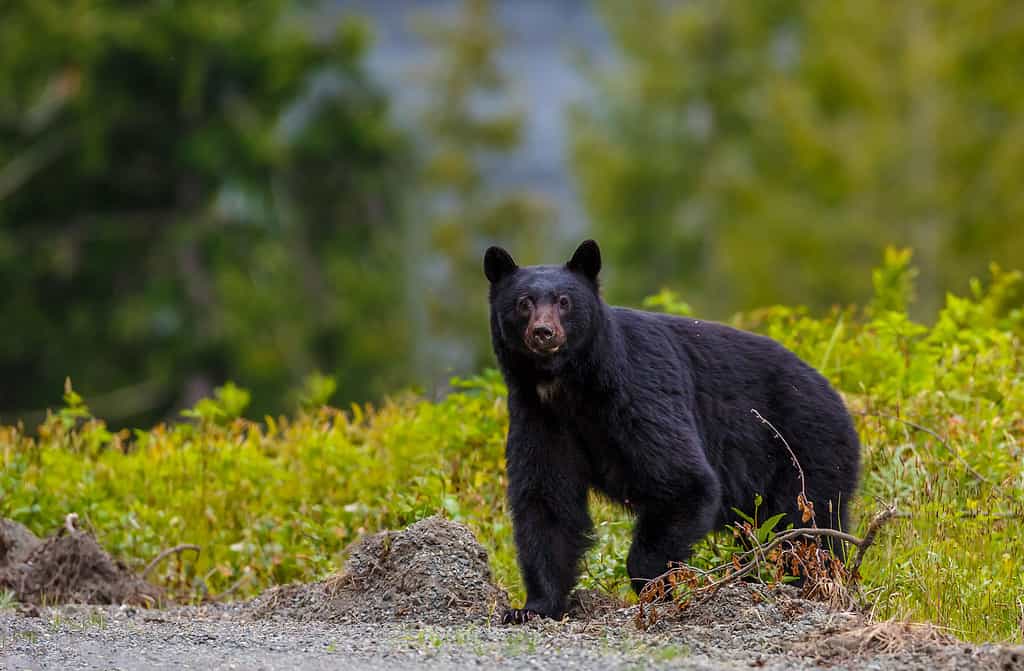
In winter, moose can be unpredictable and aggressive, particularly when confronted by humans or dogs.
©Menno Schaefer/Shutterstock.com
The black bear, in contrast to the grizzly bear, is throughout Montana. This sizable creature measures between 4 and 7 feet long, stands 2 to 3 feet high at the shoulders, and features a lengthy brown snout, tiny eyes, round ears, a substantial body, and a brief tail.
State wildlife authorities estimate that around 15,000 black bears reside in Montana, although the actual population might be larger than previously believed.
Although black bear attacks are uncommon, they have accounted for 61 human deaths in North America since 1900. It’s crucial to treat black bears respectfully and maintain a safe distance.
Luckily, actual encounters with black bears are infrequent, and knowing how to respond when faced with one and recognizing the uncommon nature of such incidents can help individuals remain secure and comfortable. In case of a bite, bear bites might result in typical animal bite infections, including abscesses, sepsis, and even rabies.
It’s important to note that black bears have an impressive bite force of up to 800 psi, making them five times stronger than an average human. They also have an average tooth length of 2.5 inches.
Moose (Alces alces)
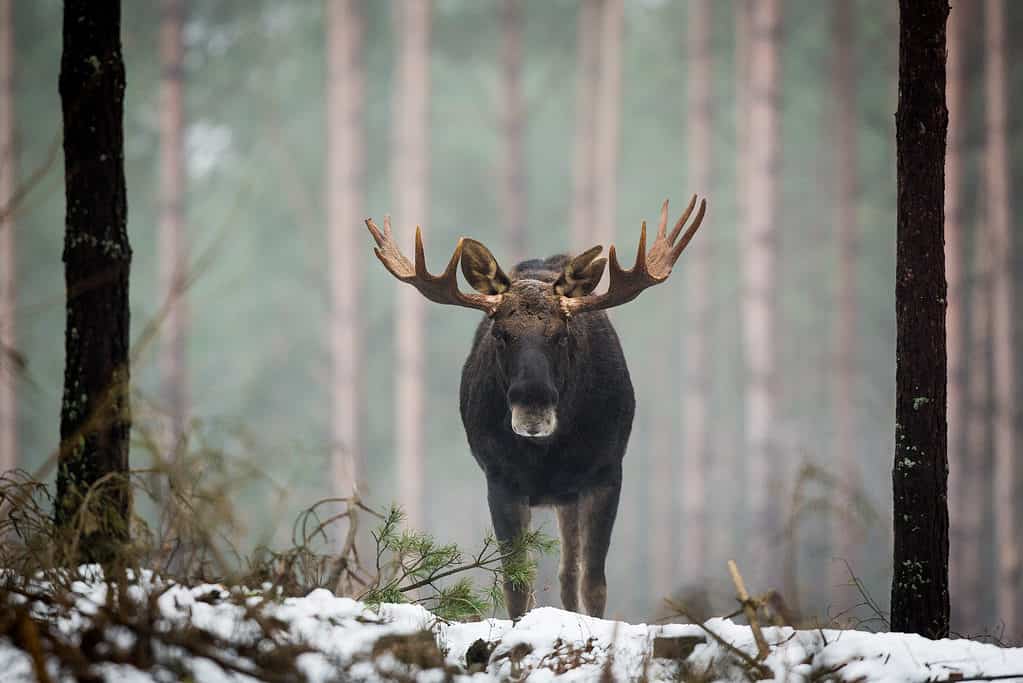
In winter, moose can be unpredictable and aggressive, particularly when confronted by humans or dogs.
©Szczepan Klejbuk/Shutterstock.com
Moose are commonly in forested landscapes in Montana, where they prefer areas with streams and ponds. The availability of water and vegetation dictates their habitat location.
With a long head and a prominent nose and upper lip, the moose has distinct physical features. Its small ears, tail, and dewlap hanging from the throat are also noticeable. The animal has a humpbacked appearance due to its powerful shoulder muscles. Male moose, or bulls, have broad and flat antlers that can span up to 5 to 6 feet across.
The state of Montana is home to around 5,000 moose.
Moose are part of a large number of collisions with vehicles in the United States. These collisions cause numerous fatalities and injuries, as well as economic losses of more than US$10 billion per year. Due to their size and height, collisions with moose are especially dangerous.
In winter, moose can be unpredictable and aggressive, particularly when confronted by humans or dogs. Deep snow, hunger, and fatigue can contribute to their frustration. An aggressive moose may display signs such as raised neck and back hairs and flattened ears against its head.
Surprisingly, moose attack more humans than bears and wolves together in North America.
The photo featured at the top of this post is © iStock.com/HRossD
Thank you for reading! Have some feedback for us? Contact the AZ Animals editorial team.






